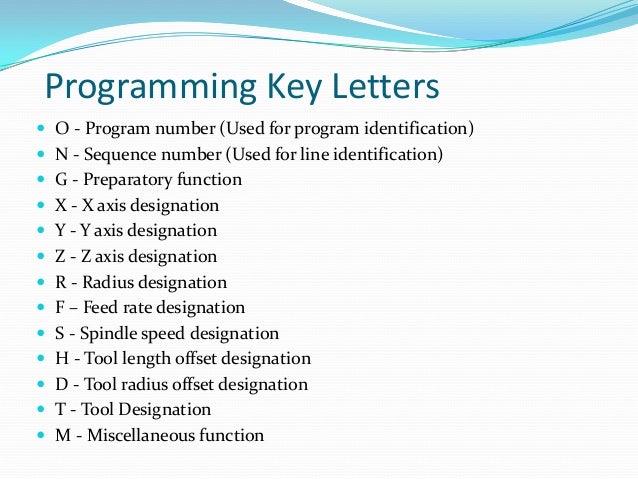Simple Program Cnc Turning
CNC Lathe Programming for Turning CNC Lathe Axes CNC Lathes come in a variety of configurations, but for the basics, we’ll stick to the simplest and most common setup–2 axes. Simple CNC Lathes use a Z-axis, which is parallel to the spindle axis, and an X-axis, which is at right angles to the spindle. In, the display looks like this: X-Axis runs top to bottom while Z-axis runs left and right The G-Wizard E ditor will automatically switch its axis display when you change the machine type from mill to lathe and vice versa.
Cncsimple 2.0 is a software for easy generation of G-Code. Briefly, I show you an example of use. If we want to create an external turning we selected the. This cnc programming example will be a good source of cnc program learning for novice cnc programmers and cnc machinists. CNC Lathe Simple G Code Example – G code Programming for Beginners. G code Programming for Beginners. Simple Contour Turning with Radius CNC Lathe Program.
The next step up from a 2-axis lathe would be a 3-axis lathe. Rather than add the Y-axis, a 3-axis lathe typically has X, Z, and C axes. C is a rotary axis parallel to the spindle axis and Z. In essence, it allows you to clock the spindle to specific angles.
A three axis lathe with live toolign can do fairly arbitrary milling jobs on the part in the lathe chuck. Heintje Weihnachtslieder. We won’t spend any more time talking about C-axis programming in this section because it’s beyond the scope of a simple introduction to CNC turning.
Diameter Versus Radius Mode Your CNC lathe’s controller will be setup to start in either diameter or radius mode. In diameter mode, X-axis values specify diameters, while in radius mode, they specify a radius from the axis. As you would expect, diameter mode X-axis values are exactly twice what the radius mode values are, so it is important that you know which mode your lathe is using.


G-Wizard Editor has a revision command that lets you change programs back and forth between diameter and radius mode: Lathe diameter mode is simple: multiply all the X’s by 2 As you can see, it ain’t rocket science–we use the Adjust Addresses Revision to multiply all the X’s by 2. Some machines may also have the ability to change between radius and diameter mode using special g-codes.. Many machines also implement a gcode that lets you switch back and forth: – G190: Radius mode. – G191: Diameter mode. Basic G01 and G02/03 Moves: Lines and Arcs The CNC Lathe can make the same basic moves as the mill–G01 for lines and G02/03 for arcs (plus G00 for rapid motion in a straight line).
The difference is you can mostly ignore the Y coordinate (though there are lathes that have Y too!). Just leave it out of the programs, and don’t use the corresponding incremental “J” or “V” either. Once you get used to it, lathe programming is quite a bit easier than mill programming. You are typically trying to create a profile of some kind. If your lathe has, this can be particularly easy, but even programming by hand isn’t too bad. Part Zero on CNC Turning Programs It’s worth putting a little thought into where you’d like to put part zero on a turning program.
The X-axis zero is always chosen to be the spindle center line when turning for all sorts of reasons. For the Z-axis zero, there are three popular spots to choose from: – Chuck face: The only advantage to this method is it is very each to touch the chuck face. But, the part is rarely against the chuck face, so this method introduces more complications in locating positions on the actual part. – Chuck jaw face: This one is a little better, as it is both easy to measure and will also establish part zero at the end of the part that is pressed firmly against the jaw face. But, we can do even better. – End of finished part: This is the most popular approach, the reason being a lot of parts have to be flipped in the chuck and machined on both ends.
The disadvantage is that when machining starts, there is no finished part to touch off. Machinists typically use an allowance, or make a quick facing cut to create the finished end to get past that problem. Tool Changes and Tool Selection on the CNC Lathe There are a couple of differences between typical CNC Lathe tool changes and Mill tool changes. First, the lathe uses no M06 command–the tool is changed as soon as the “T” word is executed. Second, many lathes encode a tool wear offset into the address following the “T” word: Tttww In the example “tt” signifies the tool number and “ww” signifies the wear offset. Different controls may be set up with differing numbers of digits to select the tool and wear offset.
CNC Lathes are set up this way so that each tool can have more than one wear offset. This is done because turning work often needs to be to very tight tolerances, and the same tool is often used for multiple features on the part.
By using a different wear offset for each feature, the machinist can measure the parts as they come off and tweak the wear offset so each feature is to the specified tolerances. This all assumes your lathe has a tool turret. It may not–some lathes use Gang Tooling. It’s beyond the scope of this intro chapter, but gang tooling will be covered in a later article. Suffice to say that with gang tooling, the tools are mounted on the slide and the program selects the tool by explicitly programming slide motions on the X and Z axes.